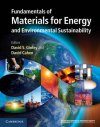Textbook
By: David S Ginley(Editor), David Cahen(Editor)
772 pages, 450 colour illustrations, 80 tables
![Fundamentals of Materials for Energy and Environmental Sustainability Fundamentals of Materials for Energy and Environmental Sustainability]()
Click to have a closer look
About this book
Contents
Customer reviews
Biography
Related titles
About this book
How will we meet rising energy demands? What are our options? Are there viable long-term solutions for the future? Learn the fundamental physical, chemical and materials science at the heart of: Renewable/non-renewable energy sources, Future transportation systems, Energy efficiency and Energy storage. Whether you are a student taking an energy course or a newcomer to the field, this textbook will help you understand critical relationships between the environment, energy and sustainability. Leading experts provide comprehensive coverage of each topic, bringing together diverse subject matter by integrating theory with engaging insights.
Each chapter includes helpful features to aid understanding, including a historical overview to provide context, suggested further reading and questions for discussion. Every subject is beautifully illustrated and brought to life with full color images and color-coded sections for easy browsing, making this a complete educational package. Fundamentals of Materials for Energy and Environmental Sustainability will enable today's scientists and educate future generations.
Contents
List of contributors
Preface
Acknowledgments
Part I. Energy and the Environment: The Global Landscape:
1. A primer on climate change
2. The global energy landscape and energy security
3. Sustainability and energy conversions
4. Energy cost of materials: materials for thin-film photovoltaics as an example
5. Economics of materials
6. Global energy flows
7. Global materials flows
8. Carbon dioxide capture and sequestration;
Part II. Nonrenewable Energy Sources:
9. Petroleum and natural gas
10. Advancing coal conversion technologies: materials challenges
11. Oil shale and tar sands
12. Unconventional energy sources: gas hydrates
13. Nuclear energy: current and future schemes
14. Nuclear non-proliferation
15. Nuclear-waste management and disposal
16. Material requirements for controlled nuclear fusion;
Part III. Renewable Energy Sources:
17. Solar energy overview
18. Direct solar energy conversion with photovoltaic devices
19. Future concepts for photovoltaic energy conversion
20. Concentrating and multijunction photovoltaics
21. Concentrating solar thermal power
22. Solar-thermoelectrics: direct solar thermal energy conversion
23. Off-grid solar in the developing world
24. Principles of photosynthesis
25. Biofuels and biomaterials from microbes
26. Biofuels from cellulosic biomass via aqueous processing
27. Artificial photosynthesis for solar energy conversion
28. Engineering natural photosynthesis
29. Geothermal and ocean energy
30. Wind energy
Part IV. Transportation:
31. Transportation: motor vehicles
32. Transportation: aviation
33. Transportation: shipping
34. Transportation: fully autonomous vehicles
Part V. Energy Efficiency:
35. Lighting
36. Energy efficient buildings
37. Insulation science
38. Industrial energy efficiency: a case study
39. Green processing: catalysis
40. Materials availability and recycling
41. Life-cycle assessment
Part VI. Energy Storage, High-Penetration Renewables and Grid Stabilization:
42. Toward the smart grid: the US as a case study
43. Consequences of high-penetration renewables
44. Electrochemical energy storage: batteries and capacitors
45. Mechanical energy storage: pumped hydro, CAES, flywheels
46. Fuel cells
47. Solar fuels
48. Solar thermal routes to fuel
49. Photoelectrochemistry and hybrid solar conversion
Summary
Appendix A. Thermodynamics
Appendix B. Electrochemistry
Appendix C. Units
Index
Customer Reviews
Biography
David S. Ginley is a Research Fellow and Group Manager in the Process Technology Group, National Center for Photovoltaics at the National Renewable Energy Laboratory (NREL). He received his BS in Mineral Engineering Chemistry from the Colorado School of Mines and his Ph.D. in Inorganic Chemistry from MIT. He is also Past President of the Materials Research Society (MRS). His principal areas of interest are in the application of organic/polymer materials, transition metal oxides and hybrid inorganic/organic semiconductor-based nanomaterials to energy conversion and energy efficiency in the areas of photovoltaics, batteries, fuel cells and OLEDs. He has over 400 publications and 30 patents.
David Cahen is a Professor at the Weizmann Institute of Science. He received his B.Sc. in Chemistry and Physics at the Hebrew University of Jerusalem (HUJI) and his Ph.D. in Materials Research and Physical Chemistry from Northwestern University. He then joined the Weizmann Institute in 1976, where he started work on solar cells. Today, his research focuses on alternative, especially solar, energy sources, aiming to understand electronic transport across (bio)molecules, exploring how molecules can control such transport and looking for novel science in such systems and for possible relevance to solar cells.
Textbook
By: David S Ginley(Editor), David Cahen(Editor)
772 pages, 450 colour illustrations, 80 tables
"devotes more attention to the assessment of the many fundamental basic materials challenges that still exist...This text does an excellent job mapping out the many pathways that are currently under exploration."
- Science, March 2012


































